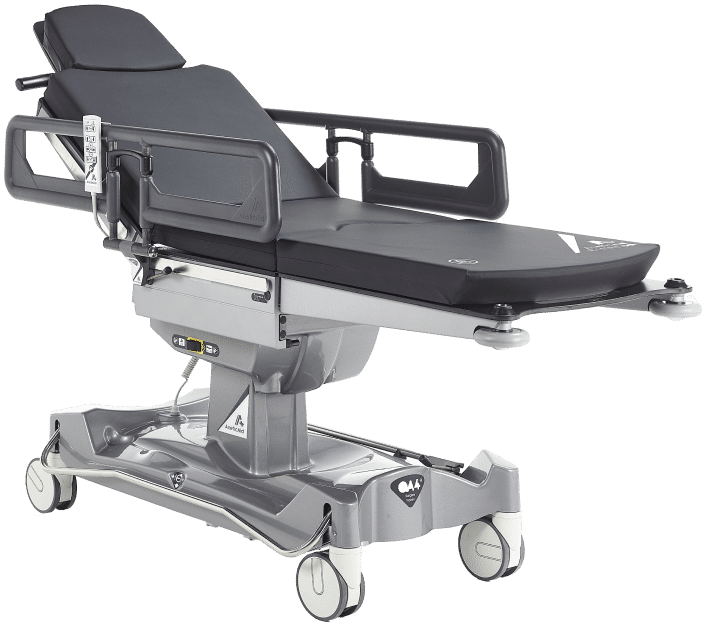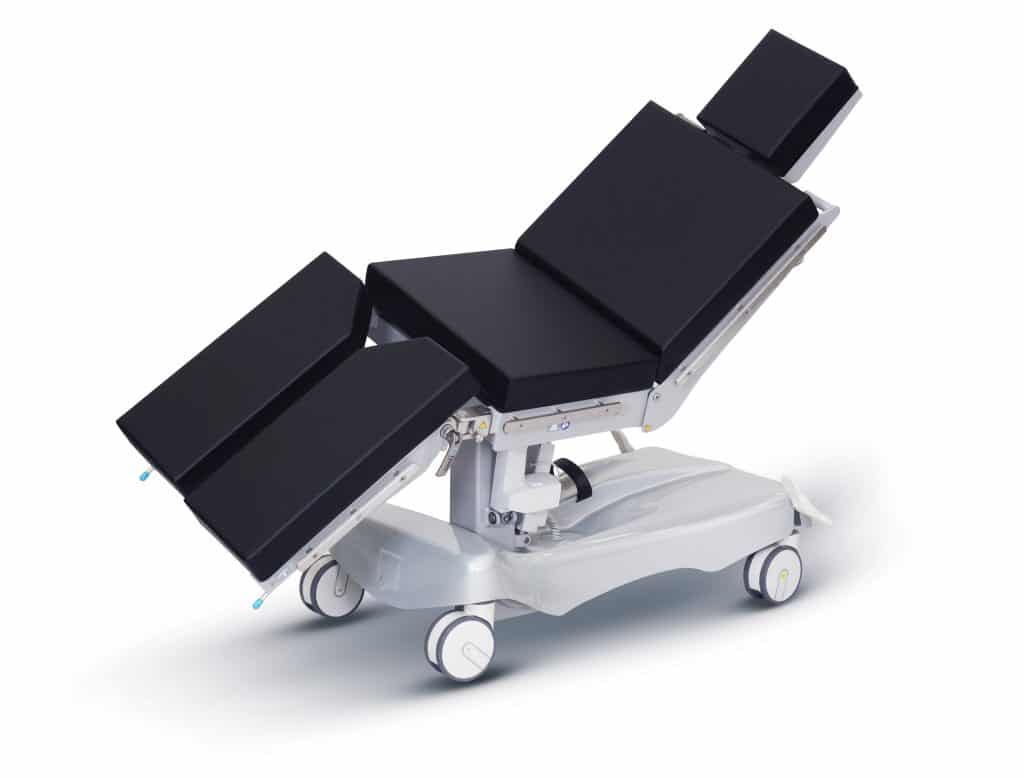AneticAid QA4 vs OpFlex Day Surgery Trolley – An Honest Comparison
There are several stretchers on the market designed for use in day surgery, and in this article, we compare one of the more common options, the AneticAid QA4, with the OpFlex Day Surgery Stretcher.
In this article, we attempt to provide an unbiased comparison of these products – and then leave you to make up your mind.
AneticAid QA4

The QA4 extremely well-known in the UK day surgery market. AneticAid blazed the trail with day surgery and the QA4 is a well-designed and high-quality product supported with great backup.
Pros of the QA4
- Electrical Height Adjustment
- Electrically powered backrest
- Great range of surgical accessories
- Electrical Lateral Side Tilt
- Longitudinal Slide
- Fifth Wheel
- Low Start Height
- Safe Working Load
Electrical Height Adjustment
The QA4 adjusts from 605 to 1005mm. This means that its start height is lower than the OpFlex – this can’t be a bad thing when considering patient mobilisation.
Electrically powered backrest
Having a powered backrest potentially means a smoother operation compared to a hydraulic or gas-assisted backrest. It also makes small tweaks to the backrest angle much easier.
Great range of surgical accessories
Not many trolleys like this will be used on their own as most need a range of accessories to adapt the standard model for different procedures. AneticAid advertise over 40 different accessories in their QA4 brochure including stirrups, armboards and their hip fix system.
Electric Lateral Side Tilt
The QA4 offers an electrical side tilt option, offering 12 degrees of movement in both directions.
Longitudinal Slide
This is a really helpful feature – 460mm of longitudinal movement (electrically powered) to assist with optimal imaging. It’s not the only way to achieve this (see OpFlex below) however a clear benefit which is not offered by its competitors.
Fifth Wheel
The QA4 has a separate Fifth Wheel in the middle of the trolley – so when used, the trolley pivots from the middle. Definitely more controllable than a directional steer wheel which is used by the OpFlex. It’s worth a quick mention that the lever to operate this is somewhat tucked away at the head section which does mean this function is not as well used as it should be.
Low Start Height
As mentioned above, the QA4 goes down lower than the OpFlex, which has got to be a good thing.
Safe Working Load
With the challenge of rising obesity, the Safe Working Load has to be a critical factor for a day procedures trolley. The QA4 has a SWL of 300kg – this is the highest in its class.
Cons of the QA4
- Adjustability of Backrest
- The need to remove the leg section for Obstetrics & Gynae
- Lateral Side tilt angle
- X-Ray Translucency
- 5th Wheel Operation
- Warranty
- Kyra Stirrups – not available
Adjustability of Backrest
The backrest on the QA4 can adjust from 0 to +80 degrees (or 0 to +85 degrees on the electrical model) – so you cannot lower below horizontal. Compare this to the OpFlex for example where you can adjust the backrest from -40 to +85 degrees and it’s easy to see the difference.
The need to remove leg sections for Obstetrics & Gynae
Some theatres complain of regularly having to lift the leg sections off in order to fit knee supports and stirrups for gynae & urology etc. This is because the leg section cannot be lowered to less than -45 degrees so they can be in the way when doing gynae and obstetrics procedures. The OpFlex does not have the same issue – see below.
Lateral Side tilt angle (note ref electrical tilt vs manual)
The side tilt angle range on the QA4 is 12 degrees in either direction and you can have a powered or manual version. The OpFlex outperforms the QA4 in this respect.
X-Ray Translucency
Whilst full X-ray translucency is stated, the electric motors are obviously not radiolucent and you cannot scan through them – the most problematic of these is the electric motor for the backrest.
5th Wheel Operation
As stated above, the pedal to deploy the 5th wheel is somewhat tucked away at the head end. Clinicians have reported that they don’t always know what this is and it’s not used as regularly as it should be.
Warranty
The standard warranty on the QA4 is 1 year – which is shorter than the OpFlex’s warranty period. Please note that AneticAid offer some extended warranties but it’s good to be clear as to what it’s included as standard.
Kyra Stirrups – not available
The Lift-Assist Lithotomy Stirrups offered with the QA4 are not bad at all, in fact, they’re really adjustable. You do however need 2 hands to operate and there are a few pinch points to be aware of. By contrast, the Kyra Stirrups offered with the OpFlex offer one-handed operation, no pinch points and thicker padding in the boot. It’s easy to understand which one the gynaecologist gravitates to. And did we mention that there’s no Velcro in a Kyra Stirrup?
OpFlex

The OpFlex is manufactured by a well-known company called FAMED, based in Poland. The model number is the SU-14. Whilst not as well known in the UK, this company is over 75 years old and their attention to quality is outstanding. The attention to detail can be noticed in areas such as the universal rails which are deburred by hand to make sure there are no sharp edges.
Pros of the OpFlex
- Great range of accessories for different procedures
- Kyra Stirrups – great for gynaecology/lithotomy
- Adjustability of Backrest
- Ability to drop Leg Section/s to -90deg
- Leg Abduction
- Best Lateral Side tilt angle
- X-Ray Translucency
- Trendelenburg Angle
- Ability to use headrests & positioning accessories from other manufacturers
- Warranty
Great range of accessories for different surgical procedures
It goes without saying that everyday surgery table needs a good range of quality surgical accessories. There are over 60 standard accessories to go with the OpFlex.
Kyra Stirrups – great for gynaecology/lithotomy
As mentioned above, these stirrups are a real game-changer. Their abduction range is the same as the Lift-Assist stirrups however the lithotomy angle range is -55 to +85 (Lift-Assist ones cannot go below -35). With no Velcro the Kyra stirrups are better for IPC and the one-handed operation is simply quicker and easier to use.
Adjustability of Backrest
The OpFlex backrest adjusts from -40 to +85 degrees. Compare this to the QA4 (0 to +80 degrees as standard) and the Rapido (-4 to +70 degrees) to fully understand just how adjustable the OpFlex backrest is.
Ability to drop Leg Section/s to -90deg
The reason this is such a positive feature of the OpFlex is because it enables the surgeon to drop the leg section right down and out of the way but there is NO need to remove it when adding stirrups etc. This saves time and heavy lifting, particularly noticeable when doing a gynae list.
Leg Abduction
It’s also worth noting that the divided legs pivot sideways to allow for leg abduction – a very helpful feature for varicose vein procedures, removing the need to purchase any dedicated accessories to achieve this functionality.
Best Lateral Side tilt angle
The OpFlex tilts to 20 degrees on both sides and this is a powered feature. By comparison, the QA4 tilts to 12 degrees in both directions (both electrical and manual options)
Trendelenburg Angle
There are 20 degrees of Trendelenburg tilt on the OpFlex compared to 12 degrees on the QA4. In some situations, this may make a difference with laparoscopic procedures such as cholecystectomy (gall bladder removal).
X-Ray Translucency
Although there’s no longitudinal shift, the lifting column is mounted at the hip area, meaning the torso is unobstructed for imaging. The backrest is fully translucent as there’s no motor obstructing the X-Ray field.
Ability to use headrests & positioning accessories from other manufacturers
Thanks to the adapters available, clinicians can use different types of headrests and head positioning accessories from the Famed portfolio and also headrest systems from third parties such as PMI (DORO) or Mayfield.
Warranty
The standard warranty is 2 years and there are longer warranties available.
Cons of the OpFlex
- No longitudinal shift
- No dedicated CPR button
- Gas-assisted backrest
- Less familiarity
No longitudinal shift
As we stated above, this feature just isn’t available. There are certain procedures for which this feature is really beneficial.
No dedicated CPR button
For CPR, lowering the backrest with the lever takes only a few seconds. Although this is pretty quick, it might be that clinicians would naturally look for a dedicated CPR button which may cause an unnecessary delay.
Gas-assisted backrest (for now)
An electrical backrest would often offer a smoother angle adjustment – however, the OpFlex is gas-assisted so may be a little less smooth. It’s worth noting that an electrical backrest option is in development by FAMED at the time of writing this article.
Less familiarity
As the OpFlex is still relatively new to the UK, not many clinicians will have had experience in using this product. It is therefore paramount that staff training is considered and planned for at the initial planning stages.
Summary
Hopefully, this article has served to explain some of the key differences between the QA4 and OpFlex stretchers. Ultimately the best judge for what to choose is you though, and there’s no better way to form a judgement than to trial the equipment in your hospital.
Felgains are exclusive suppliers of the OpFlex Day Surgery Trolley, and we offer the option for you to trial in your hospital – click here to find out more.
Related articles
What is patient flow? Statistics, challenges, and consequences of poor patient flow in the NHS
How does the Felgains MultiFlow Low-Height Stretcher improve efficiency in emergency departments?
Felgains MultiFlow Low Stretcher vs Howard Wright M9 Low Stretcher; How do they compare?
Get in touch
Got a question or want to send us a message? Let’s talk.